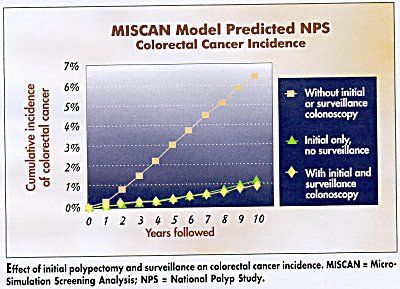Study Supports Longer Surveillance Interval Postpolypectomy
SAN DIEGO-A longer surveillance interval of 6 years or more may be appropriate for low-risk postpolypectomy patients, said Ann G. Zauber, PhD, of the Department of Epidemiology and Biostatistics, Memorial Sloan-Kettering Cancer Center. Dr. Zauber presented the study findings at the American Gastroenterology Association (AGA) meeting held during the Digestive Disease Week conference.
SAN DIEGOA longer surveillance interval of 6 years or more may be appropriate for low-risk postpolypectomy patients, said Ann G. Zauber, PhD, of the Department of Epidemiology and Biostatistics, Memorial Sloan-Kettering Cancer Center. Dr. Zauber presented the study findings at the American Gastroenterology Association (AGA) meeting held during the Digestive Disease Week conference.
She collaborated with Dr. Sidney Winawer of Memorial Sloan-Kettering on the project.
Dr. Zauber cited an earlier National Polyp Study (NPS) report of 1,418 adenoma patients, which showed that colonoscopic polypectomy with surveillance reduced colorectal cancer incidence by 76% to 90%.
Dr. Zauber noted that the malignancies were far less than expected. We wanted to understand if the incidence reduction was due to the initial polypectomy or to surveillance, she said.
Dr. Zauber explained that the relative effect of the initial polypecto-my vs surveillance colonoscopy on incidence reduction has implications for follow-up intervals, screening colon-oscopy studies, and understanding the adenoma-carcinoma progression.
The researchers used a Micro-Simulation Screening Analysis (MISCAN) model (developed at Erasmus University, Rotterdam, in conjunction with the National Cancer Institute) and NPS data to predict colorectal cancer incidence in three groups: patients with no initial polypectomy or surveillance, patients with polypectomy only, and patients with both an initial polypectomy and sur-veillance.
Dramatic Reduction
The model demonstrated a dramatic reduction in the expected incidence of colorectal cancer with an initial polypectomy with or without surveillance, leading the researchers to conclude that it is the initial polypectomy that accounts in large part for the reduction in colorectal cancer incidence. The model did, however, predict a modest benefit from surveillance after 6 years.

Colonoscopy is very effective for detecting significant adenomas, Dr. Zauber said. There wasnt much impact with the follow-up surveillance.
She said that the research team will undertake a longer term study later this summer analyzing a 6-year surveillance interval for low-risk patients and a 3-year interval for higher risk patients.